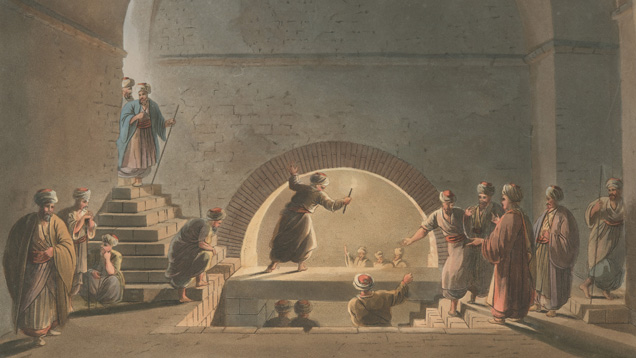Rumours of Grace: The conventional David Bowie
 CREDIT: DOROT JEWISH DIVISION, THE NEW YORK PUBLIC LIBRARY. (1804). SEPULCHRAL CHAMBERS NEAR BETHANY
CREDIT: DOROT JEWISH DIVISION, THE NEW YORK PUBLIC LIBRARY. (1804). SEPULCHRAL CHAMBERS NEAR BETHANYLazarus is a character in stories of Jesus, he passes away in the story, but Jesus resurrects him. Bowie's song however does not endorse the story, holding a ending that possibly illustrates in the end, none of us will emerge from death
I never followed David Bowie so I only accidentally heard the songs of his that became popular. And any images that I saw of him likewise weren’t ones that I sought out, they just happened to jump out at me in the record stores of the past or I would randomly come across them as I turned the pages of magazines, and later, as I browsed websites. But even from these unplanned exposures to the music and images of Bowie there was one thing that was clear: he was a serious artist.
His music was meticulously produced. His stage posturing, make up, his entire public image, all of it was carefully executed. His lyrics were intelligent. He played intelligently with the image of a modern young American. He empathized with the emotional life of the fictional Major Tom, who Bowie referenced in his song “Space Oddity”.
“Under Pressure”, a song created in collaboration with Queen, captures a Bowie who understood the crisis of the modern and post-modern world. We are driven. Increasingly technology and war demand our attention. We are anxious about survival. In this pressured world is there any room for love? Still, “Why can’t we give love another chance,” the song asks.
Bowie will be praised to the skies for pushing boundaries and challenging conventions. So, because Bowie was such a creative power, when I look at his thoughts about God I come away feeling disenchanted. Those thoughts are, well, predicable and conventional.
The Hollowverse, an online source, looks at “the religions and political views of the influential.” It documents that Bowie moved away from thinking that perhaps words like “faith” and “spirituality” had meaning. He was moving towards the rejection of the idea of God altogether.
The site quotes Bowie. “I was young, fancy free and Tibetan Buddhism appealed to me at that time. I thought, ‘There’s salvation.’ It didn’t really work. Then I went through Nietzsche, Satanism, Christianity… pottery, and ended up singing. It’s been a long road.”
According to the article, Bowie said in 2003, “I’m not quite an atheist and it worries me. There’s that little bit that holds on: Well, I’m almost an atheist. Give me a couple of months.”
What’s so cutting edge about that? To paraphrase an old expression, these days everyone and their dog feel that their connection with God is in trouble. Bowie went “from Buddhism to Christianity to pottery.” Not difficult to do since all through modern times young people have lived alongside an infinite buffet of pop ideas, ideologies, philosophy courses, spiritual side orders and evening craft programs at the local community college.
One of the songs on Bowie’s just released album is called “Lazarus”. Lazarus is a character who appears in the stories of Jesus, which date from 2,000 years ago. After Lazarus’ death, Jesus deliberately walked to the site of his entombment. He asked that the stone at the entrance be removed. The people protested that there would be a smell, but Jesus insisted. He then raised Lazarus from the dead.
Bowie’s song, however, doesn’t appear to endorse the story. In the closing scene of the video for the piece, Bowie retreats back into a wardrobe. Maybe he intended for the story of Lazarus to be a mere foil. If so the song can be seen as a response to Lazarus. Perhaps, more to the point, Bowie’s retreat into the wardrobe says that in the end none of us are going to emerge from death. Just get comfortable with it and when yours comes, climb in and pull the door shut.
Every day at millions of burials around the planet, pastors, priests, ministers and ordinary church leaders consider the accounts of the resurrection of Lazarus and others that appear in the Bible. They read the four accounts of the discovery of Jesus’ empty grave and his many appearances afterward. They repeat the post-Jesus thinking of the Bible writers about the meaning of his resurrection.
The last image of Bowie that many people will remember appears in the “Lazarus” video. Bowie has burial strips across his eyes similar to what Lazarus would have worn. Only in Bowie’s case screws hold down the strips and they are not coming off. It doesn’t have to be that way.
Editorial opinions or comments expressed in this online edition of Interrobang newspaper reflect the views of the writer and are not those of the Interrobang or the Fanshawe Student Union. The Interrobang is published weekly by the Fanshawe Student Union at 1001 Fanshawe College Blvd., P.O. Box 7005, London, Ontario, N5Y 5R6 and distributed through the Fanshawe College community. Letters to the editor are welcome. All letters are subject to editing and should be emailed. All letters must be accompanied by contact information. Letters can also be submitted online by clicking here.














